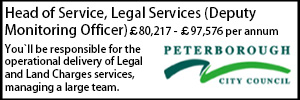Town and village greens: landowner statements and regulatory failures by the CRA
Rowena Meager reports on a recent Commons Registration Authority decision where the effectiveness of a landowner statement was in dispute.
- Details
A recent decision of the Royal Borough of Windsor and Maidenhead, as commons registration authority (“the CRA”), has confronted an issue that was foreshadowed by commentary in Gadsden & Cousins on Commons and Greens (3rd Ed, 2020) on the deposit and effect of landowner statements wherein it states “It seems likely that there will be disputes in the future about whether a landowner statement is effective to bring to an end a period of qualifying use where there is some doubt about whether all the procedural requirements have been met”, ¶15-13, and “it may be possible to argue that a statement is ineffective for the purposes of section 15A where notice has not been given in accordance with reg. 4”, ¶15-14.
The decision of the CRA related to an application to register Land off Coombe Lane (“the Application Land”) as a new town or village green (“TVG”) pursuant to section 15(2) or 15(3) of the Commons Act 2006 (“the 2006 Act”) (“the Application”). It was refused on the recommendation of the Inspector on the ground that a landowner statement had been lodged with the CRA, thus bringing any qualifying use to an end more than a year before the application was made. The Inspector also found that prohibitory signage made user contentious more than one year before the application but that reason for refusal is not dealt with in this article.
The legislation (in brief)
Material to the issues that are addressed in this article are provisions in the 2006 Act, the Commons (Registration of Town or Village Greens) and Dedicated Highways (Landowner Statements and Declarations) (England) Regulations 2013 (“the 2013 Regulations”) and the Highways Act 1980 (“the 1980 Act”):
Section 15A(1) of the 2006 Act provides:
“Where the owner of any land to which this Part applies deposits with the commons registration authority a statement in the prescribed form, the statement is to be regarded, for the purposes of section 15, as bringing to an end any period during which persons have indulged as of right in lawful sports and pastimes on the land to which the statement relates”.
Regulation 3(1) of the 2013 Regulations provides:
“A statement under section 15A(1) of the 2006 Act shall be treated as having been deposited with a commons registration authority when an application to deposit such a statement which complies with regulation 2 is given to that authority”.
Regulation 2 sets out detailed requirements in respect of a landowner statement and prescribes the form it must take. Regulation 4 details the steps that must be taken by the CRA upon receipt of a Regulation 2 compliant statement, including sending an acknowledgement of receipt to the applicant and publicising notice of receipt of the application as prescribed in Regulation 4(2).
Regulation 3(2) of the 2013 Regulations provides that where a landowner statement pursuant to section 15A(1) of the 2006 Act is combined with a deposit under section 31(6) of the 1980 Act, it shall be treated as having been given to an appropriate authority in accordance with section 322(2) and (3) of the 1980 Act. Section 322(2) prescribes the methods by which a person may ‘give’ notice but further provides that “if it is proved that [the notice] was not received by the person to whom it was addressed” it would be deemed not to have been given or served.
Landowner statement issues in this application
In the Application before the CRA a previous landowner (“the Original Owner”), who had since died, had completed a Regulation compliant combined landowner statement (pursuant to both the 2006 Act and the 1980 Act), copies of which were before the inquiry, which was said to have been lodged with the CRA on or around 6 October 2020, shortly before the Original Owner transferred the application land to a developer (“the Developer Purchaser”) (who then sold it on in a number of lots). The CRA denied receipt of that landowner statement.
There was evidence that the Original Landowner had lodged a landowner statement in the form of the completed and signed landowner statement, together with solicitor’s correspondence between the Original Owner’s solicitor and the Developer Purchaser in which it was confirmed that a landowner statement had been lodged.
Whilst the CRA denied having received the landowner statement, it became clear, in evidence, that there was no effective system of recording post that had been received by the CRA. Further, at the time of the landowner statement being lodged the CRA staff were working from home (due to Covid) and the building at which the CRA team was based was different to the postal address at which correspondence was received. On the evidence the Inspector found that “there was no proper system for logging the receipt of and / or distributing ordinary post to the relevant person, let alone landowner statements or, indeed, those statements relating to highways”.
That deficiency persisted beyond the ‘Covid era’ and the Inspector was fortified in his conclusion based on evidence that a more recent landowner statement had been sent to the CRA by one of the new lot owners (in February 2023), together with the appropriate fee, in respect of which that landowner was able to provide proof of delivery together with evidence of the appropriate fee having been rendered, but the CRA had no record of having received it and, indeed, denied receipt. The Inspector found that a landowner statement was sent to and received by the CRA, but it was then lost.
The Inspector concluded there was a serious problem with RBWM’s post room and / or the internal distribution and processing of materials sent in by members of the public, rendering it unable to fulfil its statutory function. He also found that the CRA had no proper process for handling landowner’s statements once they had been received and that the relevant officers did not understand the law relating to landowner statements. At least one landowner statement (lodged by another lot owner), receipt of which had been recorded, was not publicised in accordance with Regulation 4 of the 2013 Regulations.
The arguments and conclusion
The Applicant argued that where there has been no public notification of a deposit in accordance with Regulation 4 of the 2013 Regulations, a landowner statement will be ineffective for the purposes of section 15A of the 2006 Act (as contemplated in ¶15-14 of Gadsden & Cousins, recited above). It was submitted that section 15A(6) mandates that registration authorities follow specific steps (ie those prescribed by Regulation 4 of the 2013 Regulations) and that absent those steps being taken users of the Application Land will unknowingly lose their right to apply for registration of the land as a TVG.
Accordingly, it was submitted, in reliance upon the dicta of Lord Steyn in R v Soneji & Another [2006] 1 AC 340, ¶ [14], a distinction being drawn between mandatory requirements (as in section 15A(6) of the 2006 Act) and directory requirements, a purposive construction of the relevant legislative provisions would be appropriate where users would lose a right without their knowledge on account of the CRA having failed to comply with its statutory obligations.
For the Objector it was argued that once a Regulation 2 compliant landowner statement has been given to the CRA, according to Regulation 3 it shall be treated as having been deposited with the CRA under section 15A(1) of the 2006 Act. The effect of that deposit is that the statement is to be regarded as bringing to an end any period of qualifying user. The statutory language is clear and should be read in a straightforward way. Further, in the context of a combined statement, section 322(2) of the 1980 Act places the burden on the CRA to prove that the landowner statement was not received by it.
As set out at the beginning of this article, the Inspector made a finding of fact that the Original Owner’s landowner statement was received by the CRA and he concluded, on the authority of R (Bloomfield) v Revenue and Customs Commissioners [2019] 1 WLR 1353, ¶ [89], and McGrath v Camden LBC [2020] EWHC 369, ¶ [52]-[53], that the first step was to construe the actual words used in the legislation to ascertain whether Parliament intended total invalidity to follow. He was unable to find sufficient support for reading the 2013 Regulations in a purposive way such that the Applicant’s argument for invalidity would follow, and he found, crucially, that reading the actual statutory words “… the period of user as of right is ended upon the statement being deposited and not when that deposit is advertised. In a system where the date on which user as of right ends is the most important consideration, Parliament ought to be taken to have been very particular when it used this language … “.
Whilst an Inspector’s conclusion is not binding authority his analysis of and conclusions upon the argument that regulatory failures on the part of the CRA might render a validly constructed and deposited landowner statement invalid are welcome and, in the author’s view, absolutely correct. Whilst this Application would have failed in any event on account of prohibitory signage that rendered continuing user vi more than a year before the one year grace period in section 15(3) of the 2006 Act, the attention that has been given to the meaning of the statutory provisions that govern landowner statements in the TVG context is nevertheless very welcome.
Rowena Meager is a barrister at No5 Chambers. She represented the successful Objector in this case, which was the subject of a public inquiry over 8 days in February / March 2024 (the CRA’s decision was made on 22 April 2025 following the Inspector’s report dated 31 December 2024).
Trust Solicitor (Employment & Contract Law)
Senior Lawyer - Contracts & Commercial
Contracts & Procurement Lawyer
Lawyer - Property
Locums
Poll










































